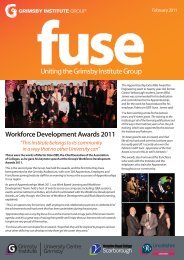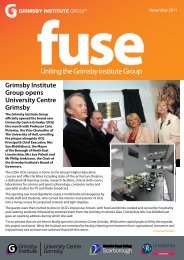Journal of Research & Scholarly Output 2006 - Grimsby Institute of ...
Journal of Research & Scholarly Output 2006 - Grimsby Institute of ...
Journal of Research & Scholarly Output 2006 - Grimsby Institute of ...
Create successful ePaper yourself
Turn your PDF publications into a flip-book with our unique Google optimized e-Paper software.
The intention <strong>of</strong> this study was to investigate<br />
the reasons contributing to the<br />
contemporary bias against sequential art in<br />
the United Kingdom. Whilst further events<br />
during the twentieth century reinforced and<br />
amplified this bias up to the present day, the<br />
conclusion is that attitudes to image-based<br />
narrative were significantly altered during<br />
the events <strong>of</strong> the Reformation, and<br />
confusion regarding the nature <strong>of</strong> sequential<br />
art’s purpose and usage was generated by<br />
the development <strong>of</strong> the political cartoon<br />
during the Eighteenth Century. Increasingly,<br />
media and literary critics are vocalising their<br />
conclusions that sequential art deserves the<br />
same respect as other written media (16), be<br />
it prose, scriptwriting or poetry, but the<br />
magnitude <strong>of</strong> the historical events that<br />
changed cultural attitudes towards imagebased<br />
storytelling in this country were <strong>of</strong><br />
such a scale that their effects are felt even<br />
today. The irony is that, at some stage,<br />
everyone in this country relies upon a<br />
combination <strong>of</strong> text and imagery presented<br />
in a sequential manner when learning to<br />
read - but perhaps this in itself is a further<br />
significant reason why the British continue<br />
to believe that ‘comics are for kids’.<br />
FOCUS Page Page 81

















